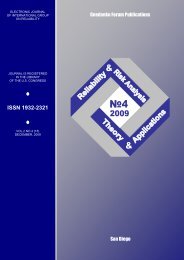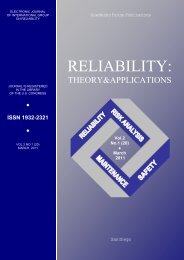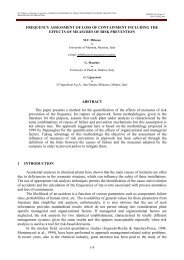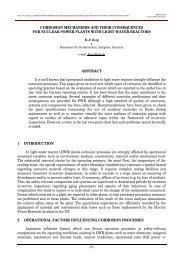7 CHI-SQUARED GOODNESS OF FIT TEST FOR GENERALIZED BIRNBAUM ...
7 CHI-SQUARED GOODNESS OF FIT TEST FOR GENERALIZED BIRNBAUM ...
7 CHI-SQUARED GOODNESS OF FIT TEST FOR GENERALIZED BIRNBAUM ...
You also want an ePaper? Increase the reach of your titles
YUMPU automatically turns print PDFs into web optimized ePapers that Google loves.
M. S. Nikulin and X. Q. Tran – <strong>CHI</strong>-<strong>SQUARED</strong> <strong>GOODNESS</strong>-<strong>OF</strong>-<strong>FIT</strong> TETS <strong>FOR</strong> <strong>GENERALIZED</strong> <strong>BIRNBAUM</strong>-SAUNDERS MODELS <strong>FOR</strong>RIGHT CENSORED DATA AND ITS RELIABILITY APPLICATIONSRT&A # 02 (29)(Vol.8) 2013, JuneX = T ∧ C ,δ = 1 { }, i = 1, 2, ⋯ , n.Defined thatf(t, θ)S(t, θ) = P θ (T > t); λ(t, θ) =S(t, θ) , Λ(t, θ) = − ln{S(t, θ)} , θ ∈ Θ ⊆ R ,be the survival, hazard rate and cumulative hazard functions, respectively. Denote by G and g arethe survival and the density function of the censoring time C , respectively. Supposing that the rightcensoring is non-informative which means that the function G does not depend on θ. So in thiscase, we obtain the following expressions for the likelihood function L(θ)L(θ) = f (X , θ)S (X , θ)g (C )G (C ).So the members with G and g do not contain θ, so they can be rejected. The likelihoodfunction is obtainedL(θ) = f (X , θ)S (X , θ) = λ (X , θ)S(X , θ) . (7)The estimator θ maximizing the likelihood function L(θ). The log-likelihood function isl(θ) = {δ ln λ(X , θ) + ln S(X , θ)}= {δ ln λ(X , θ) − Λ(X , θ)}.The maximum likelihood estimator θ satisfies the system equationsl̇θ = 0 ,where l̇(θ) are the score vectorswherel̇(θ) = l(θ) = l(θ) The Fisher information matrix is defined asI(θ) = −E l̈(θ),l̈(θ) = δ ∂ ∂θ ln λ(X , θ), l(θ), ⋯ , l(θ) . − ∂∂θ Λ(X , θ) .Supposing that θ is the true value of θ, under some regularity conditions, we haveθ → θ ; √n θ − θ = i (θ ) 1√n l̇(θ ) + O (1) , −1√n l̈θ → i(θ ),√n(θ − θ ) → 1N (0, i (θ ));√n l̇(θ ) → N (0, i(θ )),where, θ are the maximum likelihood estimation of θ and the matrixI(θi(θ ) )= lim → n .For any t ≥ 0, setN (t) = 1 { , } = 1, if t ≥ X and δ = 1,; Y0, if 0 ≤ t ≤ X . (t) = 1 { } = 1, if t ≤ X ,0, if t > X .N(t) = N (t) , Y(t) = Y (t).The process N(t) shows the number of observed failures in the interval [0, t] and the processY(t) shows the number of objects which are "at risk" just prior to time t. The sample (6) isequivalent to the sample (8)12
















